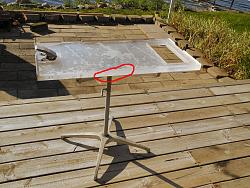I have been wasting my time on a frivolous shop project.
I have a fish cleaning table. The red mark is where an etched brass nameplate goes that wasn’t yet made when the photo was taken in 2016. The table was a gift from a friend whose late hubby had made it, so I named it “Herb’s table” in his memory. The gut bucket goes under the rectangular opening. The top is 1” thick polycarbonate. The base is an aluminum casting. I don’t know how the base and column originated; maybe a little lightweight work table or possibly a microphone stand.
The column fits into tapered sockets both at the base and into the table. I want to separate the top from the column when I’m done cleaning fish so I can take the top to the hose and hose it off. Problem is, when I want to separate the top from the column, sometimes the top comes off the column and sometimes the column and tabletop come out of the base. Nuisance! I wanted to lock the column impermanently and reversably to the base. Impermanent and reversable ruled out just smearing epoxy on the taper and jamming it in to the base. I could have just cross-drilled and stuck in a cotter key or pin, but that would be a crude and inelegant kludge solution unworthy of the table’s provenance.
I decided to make a reverse or internal collet, a slotted sleeve with a tapered internal bore that could be expanded by a tapered plug when the plug is drawn in by a bolt.
The sleeve is made of aluminum with a 10 degree taper on the bore.

The tapered plug is made of nylon.
The 1/16” dia stainless steel pins engage the slots in the collet to keep it from turning when the bolt is tightened into the knurled threaded steel insert that fits into the hole in the plug.
This part is threaded ¼-20 to accept an ordinary hex-head stove bolt from the bottom. It’s a force-fit into the hole so the knurls bite into the plastic, rotationally locking them together. I later realized that the pins would do that anyway, oh well. The bolt pulls on the insert which draws the plug into the collet, expanding the collet and jamming it into the column. There’s a little ridge inside the column that the top lip of the collet engages. The top lip is tapered so I could drive the collet into the column with a hammer, springing the sides in until the lip passed the internal ledge. Then the tapered plug would force it to expand into place.
The 2” diameter aluminum bottom washer
has slots that engage tits on the bottom of the collet to keep the collet (and hence the knurled insert) from rotating when the bolt is tightened. The bolt goes up thru the center hole. I just grabbed the washer with a pair of channel locks to keep it from turning when I tightened the bolt during assembly.
Here's how it all goes together:
I didn't take actual photos of the various parts because I finished this about midnight the day before we left for the lake. I did, however, really make it and it works perfectly.


 LinkBack URL
LinkBack URL About LinkBacks
About LinkBacks







 Reply With Quote
Reply With Quote



Bookmarks